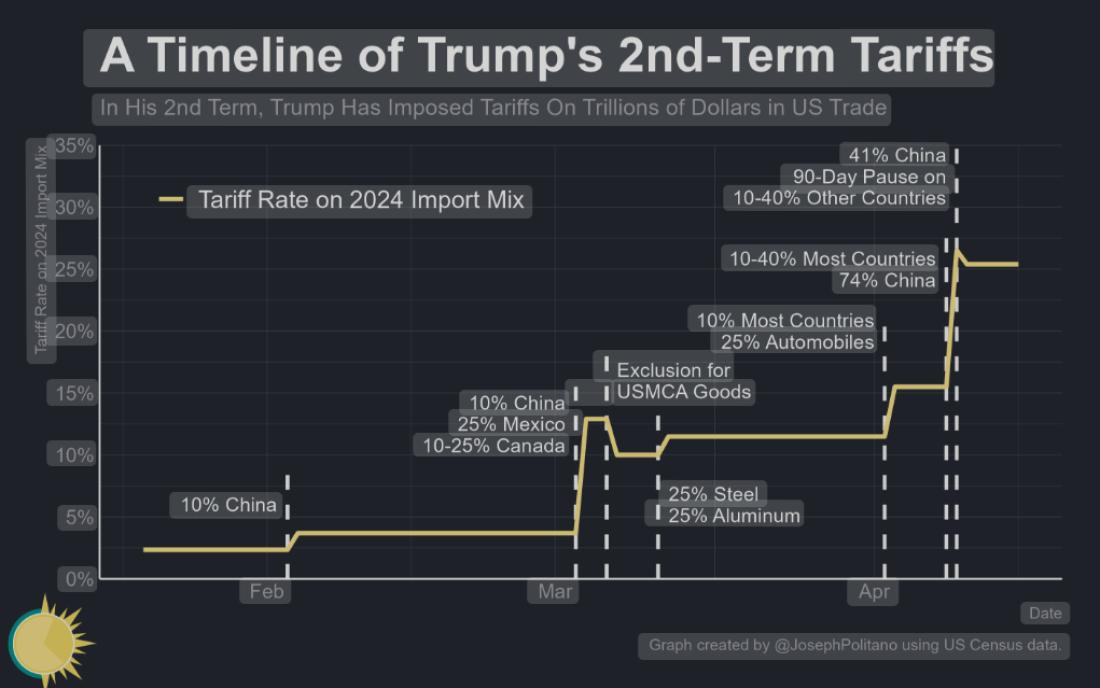China launches nationwide fire safety inspection after Hong Kong inferno
China announced a sweeping inspection of fire-safety standards in high-rise buildings nationwide on Saturday after a deadly fire in Hong Kong left at ...
You’ve probably seen the headlines: sweeping tariffs, surprise pauses, and a 90-day ticking clock that could reshape global trade. But what exactly is Trump’s 90-day pause — and why does it matter for the world economy? Let’s break it down
What is the 90-day pause?
On 2 April, former U.S. President Donald Trump declared “Liberation Day”, announcing new reciprocal tariffs on almost all U.S. imports. The policy shocked global markets. But within a week, a partial 90-day pause was introduced to ease the fallout.
The pause, announced on 9 April, temporarily suspended the steepest tariff hikes for 59 trading partners, including the EU, Vietnam, and Sri Lanka, until 9 July. However, a universal 10% baseline tariff remained in place on nearly all imports, including those from allies such as Australia and the UK.
“The pause offers a temporary reprieve, but it doesn’t undo the structural shift in U.S. trade policy,”
— Clark Packard, trade fellow at the Cato Institute
So, what stayed and what changed?
China, however, saw no relief. Its tariffs jumped from 104% to 125%, plus 20% more for fentanyl-related goods.
“This is a full-scale break from the post-WWII free trade order — and the pause only slows the reckoning,”
— Lori Wallach, global trade expert
What about the global impact?
Trump’s tariff reset could trigger a second wave of inflation, disrupt supply chains, and raise consumer prices, especially if negotiations fail and full tariffs kick in after 9 July.
“The threat of tariffs, and the uncertainty around them, causes capital to sit on the sidelines,”
— Clark Packard
Vietnam, for instance, exports to the U.S. make up about 30% of its GDP. A 46% tariff could devastate its economy.
The UK, which exports $9bn in cars to the U.S., now faces a 25% tariff on those vehicles.
The EU could see a 50% tariff if it doesn’t strike a deal, prompting fears of a tit-for-tat trade war.
“If this happens, the EU will likely feel compelled to respond in kind — potentially sparking a full trade war,”
— Gavekal Research, investment adviser

What’s the legal picture?
The U.S. Court of International Trade ruled in May that many of Trump’s tariffs were illegal. A federal appeals court temporarily reinstated them, but a final ruling is pending.
“There’s real legal risk that the foundation of this trade policy could collapse in court,”
— David Murphy, customs and trade attorney
What could happen next?
Trade analysts expect three possible outcomes by the July deadline:
1. Full deals are reached (like with Vietnam or the UK) — removing or lowering tariffs.
2. No deal, but baseline 10% tariffs remain — continuing uncertainty.
3. No deal and no goodwill — full tariffs (up to 50%) kick in.
“Some countries will bend. Others will fight back. Either way, we’re entering a new chapter in global trade,”
— Patrick Childress, international trade lawyer
Final thoughts
Trump’s 90-day pause wasn’t just a delay, it was a warning. While some nations may strike bilateral deals, others face a steep cliff edge. As the global trading order reshapes, unpredictability may be the only constant.
“Tariffs are back — and this time, they’re not going away quietly,”
— Bloomberg Economics
At least 47 people have died and another 21 are reported missing following ten days of heavy rainfall, floods, and landslides across Sri Lanka, local media reported on Thursday (27 November).
Hong Kong fire authorities said they expected to wrap up search and rescue operations on Friday after the city's worst fire in nearly 80 years tore through a massive apartment complex, killing at least 128 people, injuring 79 and leaving around 200 still missing.
U.S. Secretary of Defense Pete Hegseth visited sailors aboard the USS Gerald R. Ford aircraft carrier in the Latin American region on Thursday, amid a military buildup by President Donald Trump’s administration that has heightened tensions with Venezuela.
Rescuers in Sri Lanka are racing against rising floodwaters and treacherous terrain today after a powerful storm system slammed into the island nation, killing at least 46 people and displacing tens of thousands in a disaster that threatens to strain the country’s resources.
The Spanish agricultural sector has been placed on high alert following the confirmation that African Swine Fever (ASF) has resurfaced in the country for the first time in over thirty years.
China announced a sweeping inspection of fire-safety standards in high-rise buildings nationwide on Saturday after a deadly fire in Hong Kong left at least 128 people dead.
The death toll from floods and landslides following cyclonic rains in the Indonesian island of Sumatra has risen to 303, the head of the country's disaster mitigation agency said on Saturday, up from a previous figure of 174.
Hong Kong on Saturday mourned the 128 people known to have died in a massive fire at a high-rise apartment complex, a toll that is likely to rise with 150 still missing days after the disaster.
The global recall of Airbus A320 aircraft has triggered widespread disruption across several major airlines, forcing flight cancellations in the United States, Japan, Australia and New Zealand.
Pope Leo visited Istanbul’s Blue Mosque on Saturday, stepping inside one of the most iconic sites of the Muslim world. He removed his shoes at the entrance in a gesture of respect. He did not appear to pray.
You can download the AnewZ application from Play Store and the App Store.

What is your opinion on this topic?
Leave the first comment